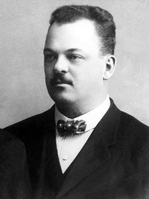










In 1905, Gideon Sundback started to work at Westinghouse Electric and Manufacturing Company in Pittsburgh, Pennsylvania. In 1906, Sundback was hired to work for the Universal Fastener Company of Hoboken, New Jersey. Subsequently in 1909,Sundback was promoted to the position of head designer at Universal Fastener.
Sundback made several advances in the development of the zipper between 1906 and 1914, while working for companies that later evolved into Talon, Inc. He built upon the previous work of other engineers such as Elias Howe, Max Wolff, and Whitcomb L. Judson
He was responsible for improving the "Judson C-curity Fastener". At that time the company's product was still based on hooks and eyes. Sundback developed an improved version of the C-curity, called the "Plako", but it too had a strong tendency to pull apart, and was not any more successful than the previous versions. Sundback finally solved the pulling-apart problem in 1913, with his invention of the first version not based on the hook-and-eye principle, the "Hookless Fastener No. 1". He increased the number of fastening elements from four per inch to ten or eleven. His invention had two facing rows of teeth that pulled into a single piece by the slider, and increased the opening for the teeth guided by the slider.
The patent for the "Separable Fastener" was issued in 1917. Gideon Sundback also created the manufacturing machine for the new device. The "S-L" or "scrapless" machine took a special Y-shaped wire and cut scoops from it, then punched the scoop dimple and nib, and clamped each scoop on a cloth tape to produce a continuous zipper chain. Within the first year of operation, Sundback's machinery was producing a few hundred feet (around 100 meters) of fastener per day.
In 1914, Sundback developed a version based on interlocking teeth, the "Hookless No. 2", which was the modern metal zipper in all its essentials. In this fastener each tooth is punched to have a dimple on its bottom and a nib or conical projection on its top. The nib atop one tooth engages in the matching dimple in the bottom of the tooth that follows it on the other side as the two strips of teeth are brought together through the two Y channels of the slider. The teeth are crimped tightly to a strong fabric cord that is the selvage edge of the cloth tape that attaches the zipper to the garment, with the teeth on one side offset by half a tooth's height from those on the other side's tape. They are held so tightly to the cord and tape that once meshed there is not enough play to let them pull apart. A tooth cannot rise up off the nib below it enough to break free, and its nib on top cannot drop out of the dimple in the tooth above it. U.S. Patent 1,219,881 for the "Separable Fastener" was issued in 1917.
The name zipper was created in 1923 by B.F. Goodrich, who used the device on their new boots. Initially, boots and tobacco pouches were the primary use for zippers; it took another twenty years before they caught on in the fashion industry. About the time of World War II the zipper achieved wide acceptance for the flies of trousers and the plackets of skirts and dresses.
Sundback also created the manufacturing machine for the new zipper. Lightning Fastener Company, one early manufacturer of the zipper, was based in St. Catharines, Ontario. Although Sundback frequently visited the Canadian factory as president of the company, he resided in Meadville, Pennsylvania and remained an American citizen. Sundback was awarded the Gold Medal of the Royal Swedish Academy of Engineering Sciences in 1951. Sundback died of a heart condition in 1954 and was interred at Greendale Cemetery in Meadville, Pennsylvania.